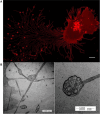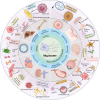Migrasomes as intercellular messengers: potential in the pathological mechanism, diagnosis and treatment of clinical diseases
- PMID: 40254563
- PMCID: PMC12009535
- DOI: 10.1186/s12951-025-03362-6
Migrasomes as intercellular messengers: potential in the pathological mechanism, diagnosis and treatment of clinical diseases
Abstract
Migrasomes are newly identified organelles that were first discovered in 2015. Since then, their biological structure, formation process, and physiological functions have been gradually elucidated. Research in recent years has expanded our understanding of these aspects, highlighting their significance in various physiological and pathological processes. Migrasomes have been found to play crucial roles in normal physiological functions, including embryonic development, vascular homeostasis, material transport, and mitochondrial quality control. Additionally, emerging evidence suggests their involvement in various diseases; however, clinical research on their roles remains limited. Current studies indicate that migrasomes may contribute to disease pathogenesis and hold potential for diagnostic and therapeutic applications. This review consolidates existing clinical research on migrasomes, focusing on their role in disease mechanisms and their use in medical applications. By examining their biological structure and function, this review aims to generate insights that encourage further research, ultimately contributing to advancements in disease prevention and treatment.
Keywords: Cell communication; Disease; Migrasome; Organelles; Pathology; Treatment.
© 2025. The Author(s).
Conflict of interest statement
Declarations. Ethics approval and consent to participate: Not applicable. Consent for publication: Not applicable. Competing interests: The authors declare no competing interests.
Figures




Similar articles
-
Migrasomes: Emerging organelles for unveiling physiopathology and advancing clinical implications.Life Sci. 2024 Dec 1;358:123152. doi: 10.1016/j.lfs.2024.123152. Epub 2024 Oct 23. Life Sci. 2024. PMID: 39454990 Review.
-
Migrasome: a novel insight into unraveling physiological and pathological function.Mol Biol Rep. 2025 May 28;52(1):509. doi: 10.1007/s11033-025-10615-y. Mol Biol Rep. 2025. PMID: 40434508 Review.
-
Migrasome, a migration-dependent organelle.Front Cell Dev Biol. 2024 Jun 6;12:1417242. doi: 10.3389/fcell.2024.1417242. eCollection 2024. Front Cell Dev Biol. 2024. PMID: 38903534 Free PMC article. Review.
-
The roles of migrasomes in immunity, barriers, and diseases.Acta Biomater. 2024 Nov;189:88-102. doi: 10.1016/j.actbio.2024.09.013. Epub 2024 Sep 14. Acta Biomater. 2024. PMID: 39284502 Review.
-
Migrasomes, critical players in intercellular communication.Cancer Cell Int. 2025 Mar 25;25(1):113. doi: 10.1186/s12935-025-03754-6. Cancer Cell Int. 2025. PMID: 40134020 Free PMC article. Review.
References
-
- Jiang D, Jiang Z, Lu D, Wang X, Liang H, Zhang J, et al. Migrasomes provide regional cues for organ morphogenesis during zebrafish gastrulation. Nat Cell Biol. 2019;21(8):966–77. - PubMed
-
- Zhang C, Li T, Yin S, Gao M, He H, Li Y, et al. Monocytes deposit migrasomes to promote embryonic angiogenesis. Nat Cell Biol. 2022;24(12):1726–38. - PubMed
-
- Jiao H, Jiang D, Hu X, Du W, Ji L, Yang Y, et al. Mitocytosis, a migrasome-mediated mitochondrial quality-control process. Cell. 2021;184(11):2896–910. - PubMed
Publication types
MeSH terms
Grants and funding
LinkOut - more resources
Full Text Sources

